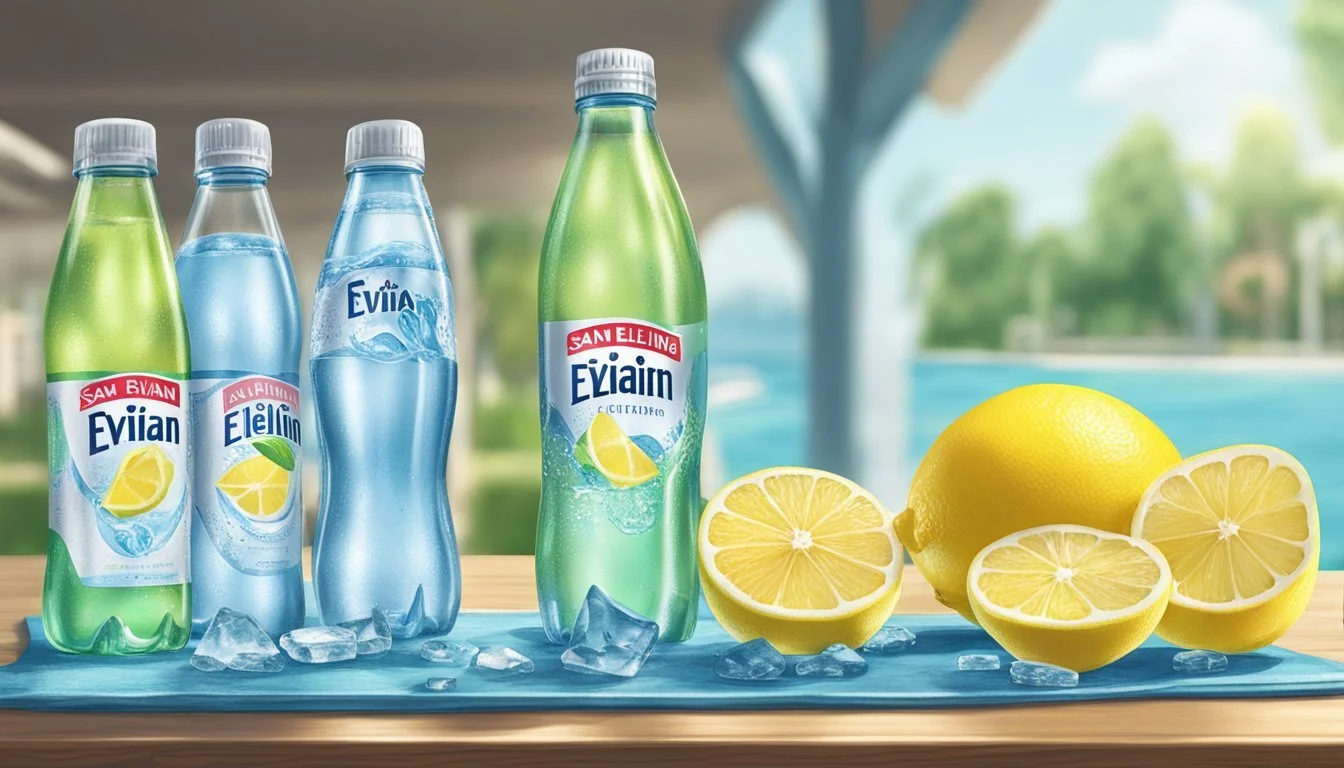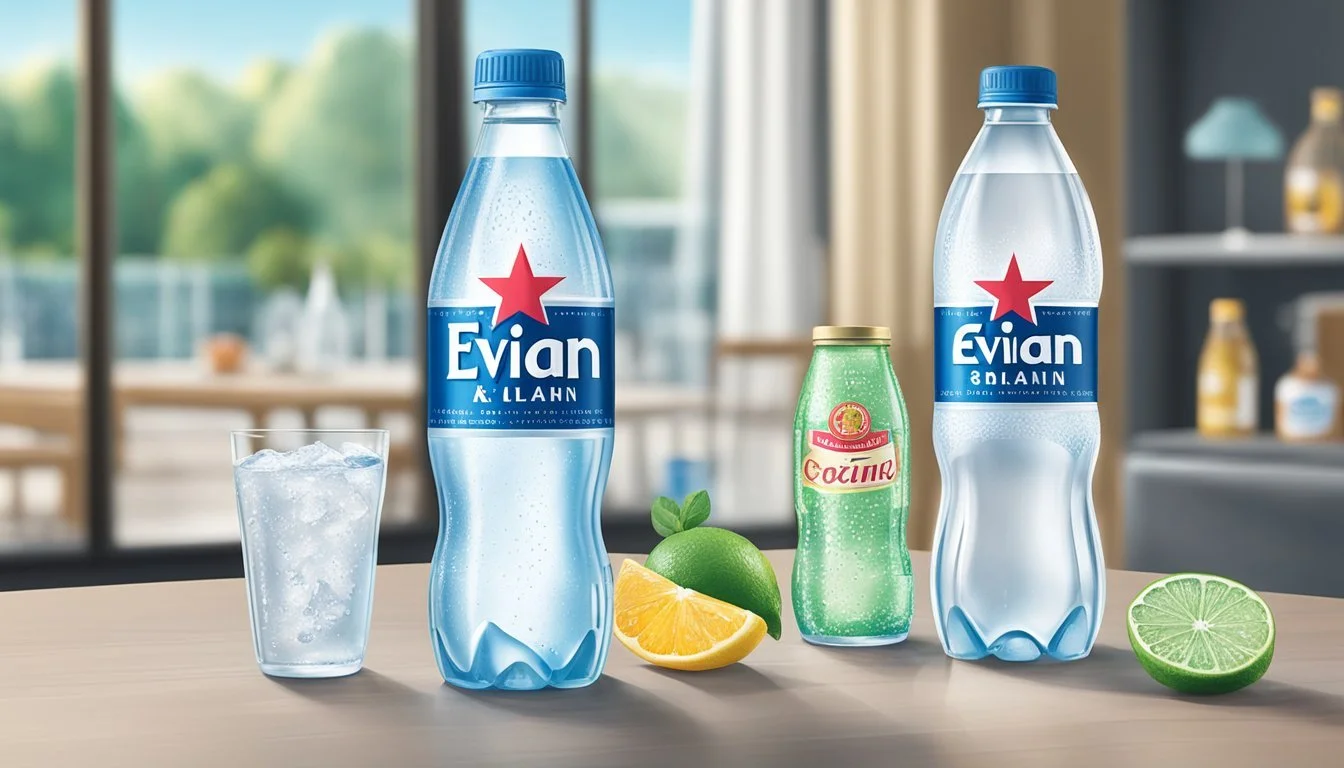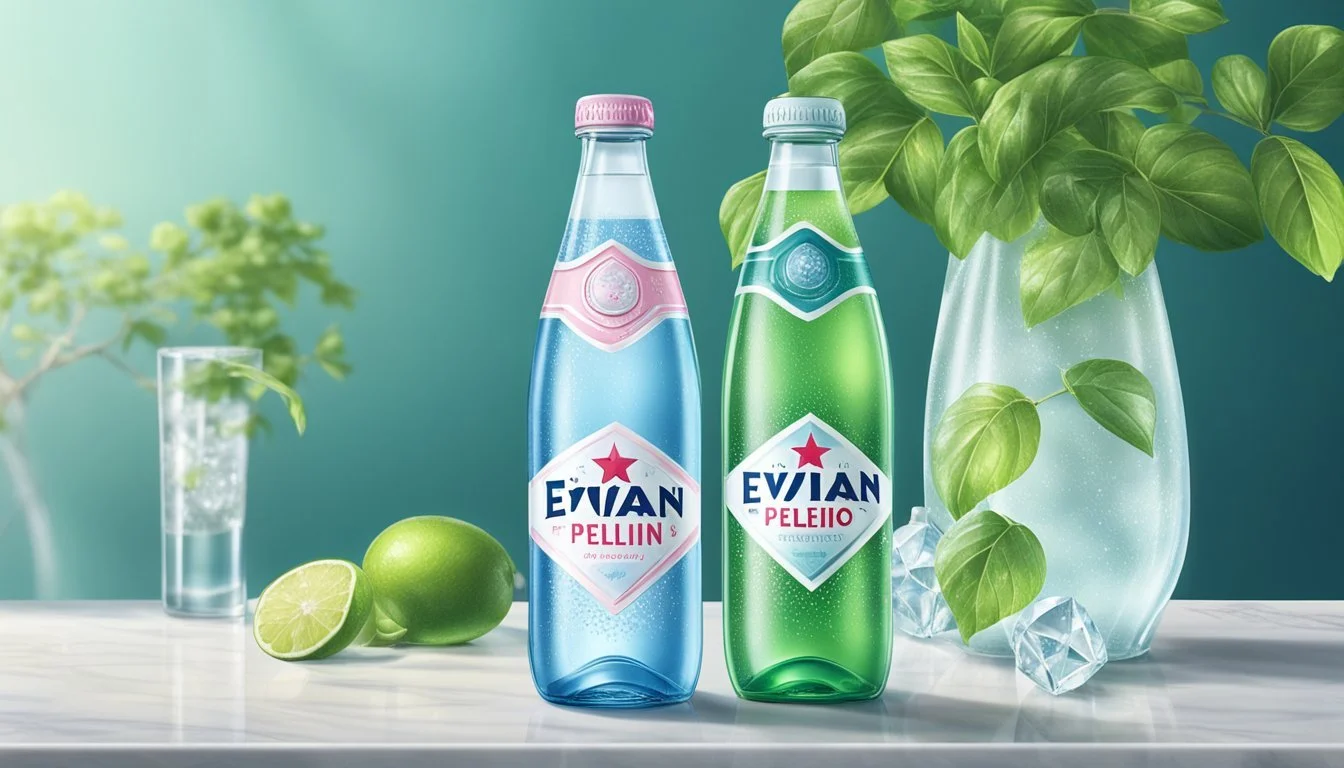Evian vs. San Pellegrino
Comparing Quality and Taste in Bottled Water
The debate between Evian and San Pellegrino bottled water often centers around taste, source, and mineral content, providing a fascinating study of preferences and qualities within the bottled water market. Evian water flows from the French Alps and is often hailed for its natural filtration process, which supposedly endows the water with a distinctive, pure taste and a balanced mineral composition. Evian's iconic brand was once so ubiquitous that its name became synonymous with bottled water itself, indicating the deep trust consumers have had in its quality.
In contrast, San Pellegrino hails from San Pellegrino Terme in Italy, where its journey through mineral-rich rock formations enriches the water with a signature blend of minerals and carbonation. It is often recognized not just for its refreshing taste but also for its status as a symbol of Italian dining elegance, often found on tables in restaurants and cafes. The presence of natural carbonation and unique mineral blend gives San Pellegrino a taste profile that is favored in gastronomy, distinguished by a fine balance of effervescence and minerality.
Evaluating which bottled water is 'better' involves not only comparing these intrinsic qualities but also considering personal preferences and the specific applications of each water type. Consumers may choose between a still and a sparkling experience, a lighter or richer mineral taste, or perhaps the water's source's ecological and ethical implications. Both Evian and San Pellegrino have carved out their own spaces in the bottled water industry, and their reputations are built on a foundation of consistent quality and brand heritage.
Understanding Bottled Water
In the realm of bottled water, consumers are presented with a variety of choices, each with its unique sourcing and mineral content. This section delineates the differences between mineral and spring waters, the types of bottled water available, and the natural sources from which these waters are procured.
Defining Mineral Water vs. Spring Water
Mineral Water is characterized by its constant level and relative proportions of minerals and trace elements at the point of emergence from the source, due to protected underground water sources. It typically originates from a geologically and physically protected underground water source. No minerals may be added to this water. In contrast, Spring Water comes from a natural spring and must be collected only at the spring or through a borehole tapping the underground formation feeding the spring.
Types of Bottled Water Available
Bottled waters are available in several forms:
Still Water: Bottled water without carbonation.
Sparkling Water: Infused with carbon dioxide to create effervescence. San Pellegrino is an example of sparkling mineral water, which may derive its carbonation from natural or added sources.
Alkaline Water: This type of water has a higher pH level than regular drinking water, often due to the presence of minerals like calcium, potassium, and magnesium.
It's important to note that some waters are also marketed with added fluoride, especially those intended for dental health benefits.
Natural Sources and Sourcing Methods
The sources of bottled water can include natural springs, artesian wells, or even municipal supplies. The methods for sourcing must adhere to stringent standards to maintain purity and quality. Mineral water, for example, may emerge from sources that are influenced by layers of rock or sediment with a history of volcanic activity, hence their mineralization. Spring water sources are typically groundwater pockets which may or may not undergo treatment. However, by law, any treatment must maintain the water's natural composition.
Health and Hydration
Choosing between Evian and San Pellegrino for health and hydration involves a deeper understanding of their mineral content, the role of hydration in bodily functions, and concerns about potential contaminants.
Minerals and Electrolytes for Health
Both Evian and San Pellegrino contain beneficial minerals that contribute to overall health. Evian water is rich in calcium and magnesium, necessary for bone health and metabolic functions. San Pellegrino, on the other hand, is known for its magnesium and bicarbonate content, which can aid in digestion. Both brands provide electrolytes, like potassium and sodium, crucial for maintaining fluid balance within the body.
Evian:
Calcium: Approx. 80mg/L
Magnesium: Approx. 26mg/L
San Pellegrino:
Magnesium: Approx. 52mg/L
Bicarbonate: Approx. bicarbonate 245mg/L
Hydration and Bodily Functions
Hydration is vital for various bodily functions, including digestion, absorption, circulation, and temperature regulation. Both Evian and San Pellegrino effectively quench thirst and can help prevent dehydration, which may lead to constipation and other health issues. The presence of minerals and electrolytes in these bottled waters supports proper hydration, better than water that lacks these nutrients.
Concerns About Contaminants
When assessing the purity of bottled water, one must consider the potential presence of contaminants. Both Evian and San Pellegrino undergo strict quality control measures to ensure the absence of harmful substances. The concerns over PFAS chemicals—synthetic compounds found in various products—have led water brands to test and report on these contaminants. Both Evian and San Pellegrino are recognized for their commitment to providing clean, safe drinking water, but it's advisable for consumers to check the latest quality reports for up-to-date information on contaminant levels.
Taste and Texture Experience
Selecting between Evian and San Pellegrino bottled waters depends significantly on individual taste preferences and the desired texture of water. This section explores their taste profiles, the influence of carbonation, and how individual health can affect taste perception.
Comparing Taste Profiles
Evian, sourced from the French Alps, is noted for its smooth, crisp taste with a neutral pH, contributing to its clean mouthfeel. The mineral content, including calcium and magnesium, affects its taste subtly, ensuring a refreshing experience without a strong mineral flavor profile.
San Pellegrino, from the Italian Alps, provides a distinctly sharp and slightly salty taste due to its higher bicarbonate and mineral content. Fans of San Pellegrino appreciate its ability to enhance the dining experience, particularly complementing Italian cuisine.
The Role of Carbonation and Bubbles
The carbonation process, where carbon dioxide (CO2) is dissolved in water, creates the effervescence known as bubbles. San Pellegrino is a sparkling mineral water, whose naturally-occurring CO2 adds a sharp fizz that is slightly more pronounced than many of its counterparts. This fizz can cleanse the palate and is often preferred by consumers for its tingling texture.
Evian, being a still water without added carbonation, provides a contrasting experience. It lacks the effervescence of sparkling waters, making it a smoother alternative for those who may find fizz to be overwhelming in taste and texture.
Health Impact on Taste Perception
The mineral content in water can influence its taste, but an individual's health, including age and presence of certain conditions like sensitivity to taste or smell, can modify one's perception. Neither Evian nor San Pellegrino contains caffeine or adaptogens that could directly affect health or aging with respect to their taste.
However, the mineral blend in the waters may aid in hydration, which can play a role in how refreshing a consumer finds the water. Generally, the taste of these bottled waters is not altered by aging as they are sealed and meant to be enjoyed within a reasonable timeframe after bottling.
Economic and Environmental Considerations
When deciding between Evian and San Pellegrino, one must consider both the economic implications and the environmental impact. These factors include the product's price, its value to the consumer, and the sustainability practices of each brand.
Price Comparison and Value
Evian and San Pellegrino are both considered premium bottled water brands, and their pricing reflects that status. Statistically, San Pellegrino has held a smaller market share with sales around $155 million, indicative of its luxury positioning. Evian, while not specified in the provided data, is often comparable in price. Consumers assess value not only in terms of cost but also the source and taste of the water, which can justify the premium price for many.
Environmental Impact of Bottled Water
The environmental impact of bottled water is multi-faceted, considering carbon dioxide emissions, plastic waste, and the filtration process. Both Evian and San Pellegrino use packaging that is subject to scrutiny concerning environmental sustainability.
Carbon Footprint: Transportation of bottled water contributes to carbon dioxide emissions. The farther the water travels, the greater the carbon footprint.
Plastic Waste: The Environmental Protection Agency (EPA) has emphasized the importance of recycling to manage plastic waste. Both brands use plastic in their packaging, increasing the demand for petroleum and the accumulation of non-biodegradable materials in landfills and oceans if not properly recycled.
Filtration Process: The filtration process, including reverse osmosis, can be energy-intensive, further contributing to environmental impact. However, specific details about the brands' filtration processes were not available in the search results.
Recycling and Alternatives: The Food and Drug Administration (FDA) regulates bottled water quality, and brands also respond to consumer demands for environmentally friendly practices. Options like boxed water or initiatives to increase recycling rates can mitigate environmental harm.
In essence, the economic and environmental considerations for choosing between Evian and San Pellegrino involve analyzing both the cost to the consumer and the ecological footprint these products leave behind.
Comparison of Brands
In the landscape of bottled waters, Evian and San Pellegrino stand out for their unique sources and production processes. This section compares these two brands in detail and explores other notable players in the industry, as well as the role of bottled water in fine dining settings.
Evian vs. San Pellegrino
Evian originates from the French Alps and prides itself on its natural filtration process. This non-sparkling mineral water is known for its balanced mineral content and neutral pH. San Pellegrino, on the other hand, is an Italian brand that has carved a niche in the sparkling water market. It boasts a crisp carbonation and a subtle mineral taste, which is a result of its 30-year journey through the Italian Alps before reaching the source.
When comparing these two, consumers often make their choice based on preference for still versus sparkling water. Evian is enjoyed for its smooth taste, while San Pellegrino is often favored by those who enjoy the sensation of fizz with an underlying minerality that complements a wide range of dishes.
Other Popular Bottled Water Brands
The bottled water market is highly competitive, with other notable brands including Perrier, another sparkling water known for its signature green bottle and unique taste due to the carbonic gas and minerals. Essentia offers ionized alkaline water that claims to better hydrate with a pH of 9.5 or higher. In the flavored sparkling water segment, brands like La Croix, Bubly, and Spindrift provide a vast array of options, focusing on natural flavors without added sugars or calories.
Non-Sparkling Brands Sparkling Water Brands Evian San Pellegrino Poland Spring Perrier Essentia La Croix Bubly Spindrift
Bottled Water in Fine Dining
Bottled water plays a pivotal role in the fine dining experience, with high-end restaurants typically offering an array of choices to their guests. Evian and San Pellegrino are staples due to their renowned names and the perceived purity of their products. Outside of these, Topo Chico has been emerging as a preferred choice for sparkling water in many fine dining establishments, prized for its strong effervescence and refreshing taste that cleanses the palate. Fine dining leverages the reputation of these branded waters to complement their offerings and enhance the overall dining experience.
Regulatory and Safety Standards
Bottled water brands, including Evian and San Pellegrino, adhere to stringent regulatory and safety standards that govern contaminants and overall quality control, ensuring the health of consumers.
FDA and EPA Guidelines
The Food and Drug Administration (FDA) regulates bottled water as a food product, setting comprehensive safety standards to protect public health. These regulations include specific limits for a range of contaminants that might be found in water. The FDA's standards are in line with the Environmental Protection Agency (EPA) guidelines for tap water, ensuring that bottled water is at least as safe as tap water. Both Evian and San Pellegrino's bottled waters comply with FDA regulations, undergoing meticulous testing for contaminants to guarantee safety for consumption.
FDA Standard Limits for Common Contaminants:
Microbiological: Established Maximum Contaminant Levels (MCL)
Chemical: Inclusive of inorganic, organic, and pesticides
Radiological: Specific limits based on type of radiation
International Standards and Quality Control
Internationally, bottled water standards can vary, but brands like Evian and San Pellegrino strive to meet or exceed such standards regardless of geographic location. Evian's quality reports indicate compliance with not only national but also international safety measures, suggesting a consistent global focus on quality control and health. San Pellegrino, sourced from Italy, is subject to European Union regulations, which are known to be rigorous, and ensures its product maintains its recognized high-quality standard across different markets.
Key Aspects of International Quality Control:
Routine Testing: Both source and finished product
Transparency: Detailed reporting and availability of water quality reports
Certification: Compliance with both local and international standards
Each brand's commitment to these regulatory frameworks and adherence to safety standards plays a crucial role in maintaining the trust and health of their consumers.
Innovations and Market Trends
The bottled water industry has seen significant shifts with the advent of functional waters and the push for more sustainable production processes. These trends reflect changing customer preferences and growing environmental concerns.
The Rise of Functional Waters
Functional waters have emerged as a pivotal market trend, catering to consumers seeking additional health benefits from their hydration choices. Brands like Evian and San Pellegrino are exploring waters enhanced with adaptogens, hemp extracts, and other ingredients catering to wellness-oriented lifestyles. These innovations are often accompanied by claims of improved mental clarity and stress relief. The contribution of reverse osmosis and advanced filtration processes ensures purity and potentially enhances the health benefits of these products.
Functional waters are increasingly segmented, with offerings like Polar creating options that focus on specific benefits, like recovery or energy, attempting to recess traditional beverage choices.
Sustainability Movements in Bottled Water
In response to environmental scrutiny, the bottled water industry is taking strides toward sustainability. Evian, for example, has committed to becoming a circular brand by 2025, emphasizing the importance of using recycled materials in their bottles. Boxed water products have also gained traction as an alternative to plastic, reducing the carbon footprint associated with bottled water.
An overview of key sustainability efforts includes:
Utilization of recycled PET for bottles.
Investments in biodegradable materials.
Implementations of water stewardship programs to minimize water waste during the filtration process.
These innovations indicate a clear direction toward a more ecologically responsible bottled water industry, affecting both market dynamics and consumer choices.
Conclusion
When considering whether Evian or San Pellegrino is the superior bottled water, one must take into account various factors such as mineral content, taste, and purity.
Evian is praised for its high mineral content, particularly calcium and magnesium, which contribute to its potential health benefits. It is sourced from the French Alps and is often recognized for its clean, refreshing taste due to the natural filtration process it undergoes.
San Pellegrino, hailing from Italy, has its own distinctive taste marked by its fine bubbles and subtle mineral nuances. Notably, San Pellegrino contains higher levels of sodium and bicarbonate, which adds to its unique profile and provides a slightly salty undertone.
Both brands have encountered concerns over microplastics, a common issue among many bottled waters. Consumers are advised to consider environmental implications and the quality of tap water available to them.
In terms of safety, both brands maintain strict quality controls to ensure their products meet global standards.
Taste: Subjective; Evian is smooth and neutral, while San Pellegrino is sparkling and more pronounced.
Mineral Content: Evian has higher calcium and magnesium; San Pellegrino is rich in sodium and bicarbonate.
Sustainability: Consider the environmental impact of bottled water and personal usage.
In conclusion, the choice between Evian and San Pellegrino comes down to personal preference regarding taste and desired mineral content. Both are considered high-quality bottled waters that stand out in the market.






